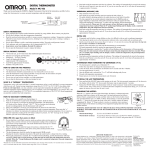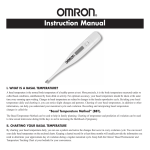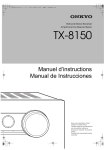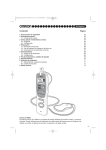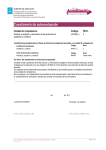Download Omron Healthcare MC-301 User's Manual
Transcript
INSTRUCTION MANUAL Basal Thermometer MODEL MC-301 Thank you for purchasing the Omron MC-301 Basal Thermometer. Fill-in for future reference Staple your purchase receipt here. DATE PURCHASED: ________________________ The thermometer you purchased offers a safe, accurate and quick temperature reading. Select oral, vaginal or rectal as your measurement site based on professional recommendation. No need to worry about broken glass or mercury hazards. Your temperature is affected by smoking, eating or drinking. Read this instruction manual completely before using your Omron MC-301 Basal Thermometer. We recommend you practice taking your temperature with the thermometer. This way you will be confident in your technique when using the thermometer. Contact your doctor if you have any questions regarding specific temperatures. This product is intended for home use only. I. WHAT IS A BASAL TEMPERATURE? A basal temperature is the normal body temperature of a healthy person at rest. For optimum accuracy, your basal temperature should be taken at the same time every morning upon waking. Changes in basal temperature are related to changes in the female reproductive cycle. By taking your basal temperature daily and charting it, you can notice slight changes and patterns. Charting of your basal temperature, in addition to other information, can help you understand your menstrual cycle and ovulation. Temperatures typically rise (about 1.0ºF (0.6ºC) within a day or so after ovulation, and are the result of heat-inducing hormone, progesterone. Recording and interpreting basal temperature changes is called the “Basal Temperature Method” (BTM). The Basal Temperature Method can be used to help in family planning. Charting of temperature and prediction of ovulation can be used to time sexual intercourse during fertile days to aid in increasing the likelihood of pregnancy. II. CHARTING YOUR BASAL TEMPERATURE By charting your basal temperature daily, you can see a pattern and notice the changes that occur in every ovulation cycle. You can record your daily basal temperature on the enclosed charts. Keeping a charted record for at least three months will usually provide the information you need to determine your approximate day of ovulation during a regular menstrual cycle. Keep both the Omron® Basal Thermometer and Temperature Tracking Chart at your bedside for your convenience. III. HOW TO TAKE ACCURATE BASAL TEMPERATURES To obtain an accurate basal temperature, you must take your temperature when you first awake in the morning. For best results, this waking temperature should be taken at the same time each morning. Since any activity may tend to raise your temperature, do not get out of bed until you have taken your basal temperature. Postpone going to the bathroom, eating, smoking or drinking until after taking your basal temperature. Cold drinks lower mouth temperature; hot drinks, smoking and exercise cause higher readings. Using an electric blanket or heating pad can affect your basal temperature. If you use one, it should be kept at the same setting each night throughout the time you are taking your basal temperature. SHOULD I USE THE ORAL, VAGINAL OR RECTAL METHOD? Since temperatures taken at different sites can vary, it is important to select one method and then take your temperature the same way everyday. You must use either the oral, vaginal or rectal method. Using more than one method will provide inaccurate results, IV. TAKING YOUR BASAL TEMPERATURE Select oral, vaginal or rectal as your measurement based on professional recommendation. ORAL METHOD ❑ ❑ ❑ ❑ ❑ ❑ w ❑ Figure 1 Place a probe cover carefully over the tip, (figure 1). Push the on/off button to turn unit on. Hold the button down to recall the last measured temperature. The thermometer will beep and the display will read: ''188.8 ° F '' This is a function check indicating the unit is working properly. Next, the thermometer will read L°F. The °F symbol will flash continuously when the unit is ready to measure temperature. Please note that the “ ” indicates a low battery. See instructions for replacing the battery before measuring temperature. Do not expect an accurate temperature reading if this low battery indicator is present. An “ERR” message in the window indicates your unit is not functioning properly. Do not drink hot or cold fluids, exercise, smoke, or perform other activities that will raise or lower temperature readings when compared to your normal, average temperature. The mouth should remain closed up to 5 minutes before attempting a reading. Place the sensor tip well under the tongue as indicated by the “✔“ (figure 2). The peak temperature should be reached in approximately 60 seconds. Opening the mouth or improper placement of the probe tip could result in a longer time for a reading. Figure 2 When the peak temperature is reached, the °F symbol will stop flashing, and the thermometer will beep repeatedly. Please note: It is not necessary to hear the beep to ensure the peak temperature has been reached. When the °F symbol stops flashing and the display reads a consistent temperature, the peak temperature has been reached. Read and record the temperature and time for reference. The reading will automatically be stored in the memory. Push the on/off button to turn the unit off. If you do not turn the unit off, it will shut off automatically in approximately 10 minutes. ❑ ❑ RECTAL METHOD Lubricate the tip of the thermometer with a water-soluble gel. Lie on your side with knees slightly bent. With one hand, gently slide the tip of the thermometer no more than 1/2 inch into the rectum. Once used rectally, the thermometer should not be used orally for sanitary reasons. VAGINAL METHOD Please seek guidance from your health care professional. V. RECORDING BASAL TEMPERATURE Please refer to the sample recording and blank temperature tracking charts enclosed. Prepare your chart following the example. Day 1 for each cycle is the first day of menstruation (your “Period”). Above the pre-printed days of the cycle enter corresponding calender dates. During your menstrual flow, it is not necessary to record temperature (unless you have short cycles). Instead, mark an X in each space provide to indicate the number of days your period lasts. Begin recording your basal temperature the first morning following the end of menstruation. For each daily temperature, trace down the column below the cycle day until it intersects with your recorded temperature. Place a dot at the intersection. The number on the chart represents tenths of a degree. A notation should be made for any rise in temperature due to illness, emotional stress, or sleeplessness. Intercourse can be indicated by placing a circle around the dot of the appropriate day. Chart your readings for at least three months in order to be sure that you have determined your approximate time of ovulation during any regular menstrual cycle. Careful temperature recording will help establish your particular pattern. Monitoring other symptoms, such as cervical mucus changes, can assist in determining the fertile days prior to ovulation. When temperature changes are used in conjunction with other fertility symptoms, such as the cervical mucus, this is known as the Sympto-Thermal Method. Determination of ovulation can be used to time sexual intercourse during fertile days to aid in the likelihood of achieving pregnancy. Completed charts should be presented to your physician or family planning counselor, who will assist you in accurately interpreting your results. VI. CARING FOR YOUR BASAL THERMOMETER Wash the tip of the thermometer with warm (not hot) soapy water before and after each use. Or, wipe the area with isopropyl alcohol before and after each use. To ensure optimum hygiene use a “Digital Probe Cover” every time a temperature is taken. CHANGING THE BATTERY The “ ” icon will display on the screen when the battery needs replacing. Remove the battery compartment lid. Use a Philips screwdriver to remove screw and washer. Remove battery. Use replacement button type 1.5v, SR41 or LR41 battery. Insert new battery with “+” polarity facing up. Use Philips screwdriver. Replace the screw and the “O” ring washer back to the original position. Replace the battery compartment lid. SCREW BATTERY WARNING: KEEP BATTERY OUT OF CHILD’S REACH. SWALLOWING BATTERY COULD BE HARMFUL. BATTERY SHOULD NOT BE CHARGED OR PLACED INTO EXTREME HEAT AS IT MAY EXPLODE. VII. THE FEMALE REPRODUCTIVE CYCLE In order to understand the Basal Temperature Method it is helpful to review the basics of human female reproductive activity. A. THE ROLE HORMONES PLAY IN OVULATION At the beginning of each menstrual cycle, the pituitary gland secretes a hormone (FSH or Follicle Stimulating Hormone), that acts upon the ovaries to prepare for ovulation. As one or more follicles in an ovary prepare for ovulation, they secrete another hormone called estrogen, that prepares the uterus for pregnancy by causing the inner lining of the uterus to thicken. Estrogen also causes some glands in the cervix to secrete a mucus discharge that is necessary for fertility. This mucus changes the environment in the vagina to make it more favorable to sperm life and provides a medium in which the sperm move upward into the uterus. The mucus typically starts as a sticky substance. During the time of fertility, it becomes more liquid and plentiful usually attaining a consistency very similar to raw egg whites. Sometimes the mucus becomes so watery that it will no longer stretch like raw egg whites, but continues to produce sensations of lubrication or wetness at the outer lips of the vagina. B. WHAT IS OVULATION? At ovulation, the ovarian follicle releases an egg which is picked up by one of the fallopian tubes and transported toward the uterus. In order for pregnancy to occur, the egg must be fertilized in the fallopian tube by sperm within 24 hours after ovulation. After 24 hours the egg disintegrates and cannot be fertilized. C. AFTER OVULATION? After ovulation, the ovarian follicle that released the egg secretes another hormone called progesterone. This hormone suppresses further ovulation. The progesterone continues to build the vaginal lining and maintains it after ovulation. It also causes the basal temperature to rise and the cervical mucus to thicken so much that it appears to dry up. Ovarian progesterone secretion continues for approximately 14 days. When it stops, the inner lining of the uterus can no longer be maintained, so it is discharged in a process called menstruation (your period), and the menstrual cycle starts again. D. HOW TO DETERMINE THE DATE OF OVULATION? By carefully taking basal temperatures upon waking and recording them on a chart, the characteristic rise in temperature can be observed. A temperature dip towards the end of the mucous pattern sometimes indicates the day of ovulation, also, the first day the temperature rises could indicate ovulation. The purpose of the chart is to help you plan future intercourses and assist you in observing your unique fertility pattern. The OMRON® Basal Digital Thermometer makes it easy to read and record the slight temperature variations which occur when ovulation has taken place. The OMRON® Basal Digital Thermometer may be used as an oral, rectal or vaginal thermometer. E. TEMPERATURE RANGES (ORAL) BEFORE AND AFTER OVULATION Your basal temperature before ovulation is usually in the range of 96.5°F to 98°F, (35.8°C to 36.7°C). The most frequent range is between 97.4°F to 97.7°F (36.3°C to 36.5°C). After ovulation the basal temperature rises about 1.0°F (0.6°C) and stays in that higher range until the beginning of the next menstrual period. The highest probability of conception is during the days immediately prior to ovulation as well as on the day of ovulation itself. Refer to the chart below for Fahrenheit/Celsius conversions. °F °C 95.0 35.0 95.5 35.3 96.0 35.6 96.5 35.8 97.0 36.1 97.5 36.4 98.0 36.7 98.5 36.9 98.6 37.0 99.0 37.2 99.5 37.5 100 37.8 F. OTHER IMPORTANT INFORMATION Remember that the thermometer is designed only to help determine when ovulation has occurred. Notation of any changes, in addition to your temperature pattern, will assist your physician or counselor in providing you with proper guidance. It is commonly suggested that couples who have had difficulty in achieving pregnancy should not have intercourse more than once a day nor on consecutive days, in order to maintain satisfactory quantities of sperm. The most fertile time continues up through the first day of drying up of the mucus or the first day of temperature elevation, whichever comes later. The temperature record should be maintained on a daily basis. If pregnancy is achieved, the basal temperature will remain elevated for several months. A temperature pattern that remains elevated for 21 days (a week or more than the usual elevated pattern) is a good indicator that pregnancy has been achieved. If you do not become pregnant after six months, see your doctor. If you believe you are pregnant, see your doctor immediately. VIII. ACCURACY Measurement Range: 90.0°F to 109.9°F / 32.2°C to 43.2°C Measurement Accuracy: 0.2°F / 0.1°C between 96.0°F to 106.0°F / 35.6°C to 41.1°C, accurate to ± 0.4°F (0.2°C) at less than 96°F and greater than 106°F. Waterproof Function: Manufactured to meet European Standard Pr EN12470-3. IX. TO RECALL THE LAST TEMPERATURE 1. Press and hold the power button while turning on the unit. The last measured temperature will be shown in the display with the letter “M” shown under the degree sign in approximately 3 seconds. 2. Release the power button. The thermometer will be in “ready-to-measure” mode and the recalled temperature will be erased. Note: If the device is switched off before completion of temperature taking, L°F will appear in memory the next time the unit is used THIS PRODUCT IS NOT FOR CONTRACEPTIVE USE X. CAUTION The effectiveness of the methods outlined for seeking and avoiding pregnancy depend on factors such as a woman’s individual reactions, the accuracy with which daily temperatures and other symptoms are recorded, and the absence of outside factors which may affect body temperature. Consequently, no representation of any kind can be made by the distributor as to the reliability of the results obtained in any individual case, and the patient is urged to consult with and be guided by the advice of her physician or counselor in the use of the OMRON® Basal Thermometer. LIMITED WARRANTIES Your MC-301 Basal Thermometer, excluding the battery, has a lifetime warranty, is warranted to be free from defects in materials and workmanship, when used in accordance with the instructions provided with the thermometer. The warranties extends only to the original retail purchaser. We will, at our option, repair or replace without charge the thermometer covered by the above warranties. Repair or replacement is our only responsibility and your only remedy under the above warranties. To obtain warranty service, ship the thermometer and all of the components, together with proof of purchase and a note explaining the problem with $5.00 for return shipping and insurance to: Omron Healthcare, Inc. Attn: Repair Department 300 Lakeview Parkway Vernon Hills, IL 60061 Be sure to include the model number, your name and your phone number on the enclosed note and any other correspondence. ALL IMPLIED WARRANTIES, INCLUDING BUT NOT LIMITED TO THE IMPLIED WARRANTIES OF MERCHANTABILITY AND FITNESS FOR PARTICULAR PURPOSE, ARE LIMITED TO THE DURATION OF THE APPLICABLE WRITTEN WARRANTY ABOVE. Some states do not allow limitations on how long an implied warranty lasts, so the above limitation may not apply to you. OMRON SHALL NOT BE LIABLE FOR LOSS OF USE OR ANY OTHER INCIDENTAL, CONSEQUENTIAL OR INDIRECT COSTS, EXPENSES OR DAMAGES. Some states do not allow the exclusion or limitation of incidental or consequential damages, so the above exclusions may not apply to you. This warranty gives you specific legal rights, and you may also have other rights which may vary from state to state. FOR CUSTOMER SERVICE (U.S. & Canada) Visit our web site at: Call toll free: www.omronhealthcare.com 1-800-634-4350 EXAMPLE OF COMPLETED BASAL TEMPERATURE CHART (with temperature readings connected to make a graph) clear opaque sticky tacky spotting OTHER OBSERVATIONS: cervix changes breast changes abdominal pain mood changes sick days SITUATIONS THAT CAN ALTER TEMPERATURE: soar throat vomiting activity cold, flu diarrhea traveling fever anxiety toothache sunburn medications alcohol elec. blanket sleep disturbances x = YOUR PERIOD • = DAILY TEMPERATURE READING • = INTERCOURSE TEMPERATURE READINGS (°F) liquid slippery yellow scant abundant 99° .9 .8 .7 .6 .5 .4 .3 .2 .1 98° .9 .8 .7 .6 .5 .4 .3 .2 .1 97° .9 .8 .7 .6 .5 OBSERVATIONS & SITUATIONS MUCUS: dry moist wet thick lubricative DATE DAY OF CYCLE NAME: Jane Smith PREVIOUS CYCLES: LONGEST SHORTEST MONTH THIS CYCLE May 35 28 29 6 7 8 9 10 11 12 13 14 15 16 17 18 19 20 21 22 23 2425 26 27 28 29 30 31 1 2 3 4 5 6 7 1 2 3 4 5 6 7 8 9 10 11 12 13 14 15 16 17 18 19 20 21 22 23 24 25 26 27 28 29 30 3132 33 34 35 36 37 38 39 40 41 42 • • xxxx • Dry Cold, Dry, Mucus Cold, Tacky, Mucus Wet, Mucus Tacky, Mucus Dry Dry Dry RECORD THESE OBSERVATIONS & SITUATIONS DAILY: R • xxxx 99° .9 .8 .7 .6 .5 .4 .3 .2 .1 98° .9 .8 .7 .6 .5 .4 .3 .2 .1 97° .9 .8 .7 .6 .5 R RECORD THESE OBSERVATIONS & SITUATIONS DAILY: clear opaque sticky tacky spotting OTHER OBSERVATIONS: cervix changes breast changes abdominal pain mood changes sick days SITUATIONS THAT CAN ALTER TEMPERATURE: sore throat vomiting activity cold, flu diarrhea traveling fever anxiety toothache sunburn medications alcohol elec. blanket sleep disturbances x = YOUR PERIOD • = DAILY TEMPERATURE READING • = INTERCOURSE TEMPERATURE READINGS (°F) liquid slippery yellow scant abundant 99° .9 .8 .7 .6 .5 .4 .3 .2 .1 98° .9 .8 .7 .6 .5 .4 .3 .2 .1 97° .9 .8 .7 .6 .5 PREVIOUS CYCLES: LONGEST SHORTEST MONTH THIS CYCLE 1 2 3 4 5 6 7 8 9 10 11 12 13 14 15 16 17 18 19 20 21 22 23 24 25 26 27 28 29 30 3132 33 34 35 36 37 38 39 40 41 42 OBSERVATIONS & SITUATIONS MUCUS: dry moist wet thick lubricative DATE DAY OF CYCLE NAME: PLEASE ENLARGE GRAPH 175% FOR BETTER VIEWING. 99° .9 .8 .7 .6 .5 .4 .3 .2 .1 98° .9 .8 .7 .6 .5 .4 .3 .2 .1 97° .9 .8 .7 .6 .5 MANUAL DE INSTRUCCIONES Termómetro Basal MODELO MC-301 Gracias por comprar el termómetro basal Omron MC-301. Complete estos datos en caso de que necesite consultarlos en el futuro Engrape aquí su recibo de compra. FECHA DE COMPRA: ______________________ El termómetro que usted compró le permite conocer la temperatura de manera segura, precisa y rápida. Seleccione el método de medición oral, vaginal o rectal según la recomendación de un profesional. Ya no necesitará preocuparse de que pueda romperse el vidrio ni por los riesgos del mercurio. Su temperatura cambia al fumar, comer o beber. Lea este manual de instrucciones en su totalidad y con atención antes de emplear su termómetro basal Omron MC-301. Le recomendamos que practique tomar su temperatura con el termómetro. De esta manera usted tendrá confianza en su técnica al usar el termómetro. Si tiene alguna duda respecto del significado de alguna temperatura específica, consulte a su médico. Este producto está diseñado sólo para ser utilizado en el hogar. I. ¿QUÉ ES UNA TEMPERATURA BASAL? Una temperatura basal es la temperatura corporal normal de una persona sana en descanso. Para una precisión óptima, su temperatura basal debe tomarse a la misma hora cada mañana al despertar. Los cambios en la temperatura basal están relacionados con los cambios en el ciclo reproductivo de la mujer. Al tomar su temperatura basal diariamente y tabularla, puede darse cuenta de leves cambios y patrones. Tabular su temperatura basal, además de otra información, puede ayudarle a entender su ciclo menstrual y ovulación. Las temperaturas se elevan (cerca de 1,0ºF (0,6ºC)) dentro de un día más o menos después de la ovulación, y son el resultado de la hormona que causa el calor, la progesterona. Registrar e interpretar los cambios de la temperatura basal se llama “Método de la Temperatura Basal” (MTB). El Método de la Temperatura Basal puede usarse para ayudar a la planificación familiar. La tabulación de la temperatura y la predicción de la ovulación pueden usarse para regular las relaciones sexuales durante los días fértiles para ayudar a aumentar la probabilidad de embarazo. II. CÓMO TABULAR SU TEMPERATURA BASAL Al tabular su temperatura basal diariamente, puede ver un patrón y darse cuenta de los cambios que se producen en cada ciclo de ovulación. Usted puede registrar su temperatura basal diariamente en las tablas adjuntas. Mantener un registro tabulado de al menos tres meses generalmente le entregará información que necesita para determinar su día de ovulación aproximado durante un ciclo menstrual regular. Mantenga tanto el termómetro basal Omron® como la tabla de seguimiento de la temperatura junto a su cama para su comodidad. III. CÓMO TOMAR TEMPERATURAS BASALES Para obtener una temperatura basal precisa, usted debe tomar su temperatura cuando despierta por primera vez en la mañana. Para lograr mejores resultados, esta temperatura al despertar debe tomarse a la misma hora cada mañana. Ya que cualquier actividad puede tender a elevar su temperatura, no salga de la cama hasta que haya tomado su temperatura basal. No vaya al baño, coma, fume ni beba hasta después de tomarse su temperatura basal. Los líquidos fríos pueden disminuir la temperatura de la boca; los líquidos calientes, fumar y los ejercicios producen lecturas más altas. El uso de una frazada eléctrica o almohadilla calefactora puede afectar su temperatura basal. Si usa una, debe mantenerla en el mismo valor cada noche durante todo el tiempo en que usted tome su temperatura basal. ¿DEBO USAR EL MÉTODO ORAL, VAGINAL O RECTAL? Ya que las temperaturas tomadas en lugares distintos pueden variar, es importante seleccionar un método y luego tomar su temperatura en la misma manera cada día. Usted debe usar ya sea el método oral, vaginal o rectal. Usar más de un método proporcionará resultados inexactos, IV. CÓMO TOMAR SU TEMPERATURA BASAL Seleccione el método de medición oral, vaginal o rectal según la recomendación de un profesional. MÉTODO ORAL ❑ ❑ Figura 1 Coloque cuidadosamente la funda de la sonda sobre la punta (figura 1). Presione el botón on/off para encender la unidad. Mantenga presionado el botón para recordar la última temperatura medida. El termómetro producirá una señal acústica y en el visor aparecerá: “”188.8 ° F ” Ésta es una verificación de funcionamiento que indica que la unidad está operando correctamente. Luego, el termómetro mostrará L°F. El símbolo °F titilará continuamente cuando la unidad esté lista para medir la temperatura. Tenga en cuenta que “ ” indica que la batería está descargada. Consulte las instrucciones para recambiar la batería antes de tomar la temperatura. No espere obtener una medición de temperatura precisa si este indicador de batería descargada aparece en el visor. El mensaje “ERR” en el visor indica que la unidad no está funcionando correctamente. No beba líquidos calientes o fríos, no realice ejercicios, no fume ni realice otras actividades que puedan aumentar o disminuir las lecturas de la temperatura comparadas con su temperatura promedio normal. Permanezca con la boca cerrada hasta 5 minutos antes de intentar efectuar una medición. Coloque el extremo de la sonda bien debajo de la lengua en los lugares marcados con un “✔” (figura 2). La temperatura máxima debería alcanzarse en aproximadamente 60 segundos. Si abre la boca o coloca de manera incorrecta el Figura 2 extremo de la sonda, tal vez sea necesario un mayor tiempo para la lectura. Cuando se alcance la temperatura máxima, el símbolo °F dejará de titilar y el termómetro producirá una señal acústica reiteradamente. Tenga en cuenta que: No es necesario escuchar la señal acústica para asegurarse de que la temperatura máxima se ha alcanzado. Cuando el símbolo °F deje de titilar y el visor muestre un valor de temperatura uniforme, se habrá alcanzado la temperatura máxima. Lea y registre la temperatura y el tiempo para tomarlos como referencia. La lectura se guardará automáticamente en la memoria. Presione el botón on/off para apagar la unidad. Si no la apaga, ésta lo hará automáticamente una vez transcurridos aproximadamente 10 minutos. w ❑ ❑ ❑ ❑ ❑ ❑ ❑ MÉTODO RECTAL Lubrique el extremo del termómetro con un gel soluble en agua. Acuéstese sobre su costado con las rodillas levemente dobladas. Con una mano, deslice con suavidad el extremo del termómetro no más de 1/2 pulgada dentro del recto. Una vez usado en forma rectal, el termómetro no debe usarse en forma oral por razones de higiene. MÉTODO VAGINAL Procure asistencia de su profesional de la salud. V. CÓMO REGISTRAR LA TEMPERATURA BASAL Consulte el registro de muestra y las tablas de seguimiento de temperatura en blanco que se adjuntan. Prepare su tabla siguiendo el ejemplo. Día 1 para cada ciclo es el primer día de menstruación (su “Período”). Sobre los días preimpresos del ciclo ingrese las fechas del calendario respectivas. Durante su flujo menstrual, no es necesario registrar la temperatura (a menos que usted tenga ciclos cortos). En lugar de ello, marque una X en cada espacio provisto para indicar el número de días que dura su período. Comience a registrar su temperatura basal la primera mañana siguiente al fin de la menstruación. Para cada temperatura diaria, trace una línea bajo el día del ciclo hasta que se intersecte con su temperatura registrada. Coloque un punto en la intersección. El número en la tabla representa las décimas de un grado. Debería anotarse cualquier alza en la temperatura debido a enfermedad, estrés emocional, o insomnio. La relación sexual puede indicarse colocando un círculo alrededor del punto en el día respectivo. Tabule sus lecturas al menos por tres meses para asegurarse de que ha determinado su momento aproximado de ovulación durante cualquier ciclo menstrual regular. El registro adecuado de la temperatura le ayudará a establecer su patrón particular. Controlar otros síntomas, tales como los cambios de la mucosa de la cerviz, puede ayudar a determinar los días fértiles antes de la ovulación. Cuando se usan los cambios de temperatura junto con otros síntomas de fertilidad, tales como la mucosidad de la cerviz, esto se conoce como el Método Sinto-Termal. La determinación de la ovulación puede usarse para regular las relaciones sexuales durante los días fértiles para ayudar en la probabilidad de lograr el embarazo. Las tablas completadas deben presentarse a su médico o consejero de planificación familiar, quien le ayudará a interpretar sus resultados en forma precisa. VI. CÓMO CUIDAR SU TERMÓMETRO BASAL Lave el extremo del termómetro con agua tibia con jabón (no caliente) antes y después de usarlo. O, limpie el área con alcohol isopropílico antes y después de usarlo. Para asegurar una higiene óptima, use una “Funda de la sonda digital” cada vez que se tome la temperatura. CÓMO CAMBIAR LA BATERÍA: El “ ” icono aparecerá en la pantalla cuando la batería tenga que recambiarse. Retire la tapa del compartimiento de la batería. Use un destornillador Philips para retirar el tornillo y la arandela. Retire la batería. Use una batería de recambio tipo botón de 1,5v, SR41 o LR41. Inserte la nueva batería con la polaridad “+” hacia arriba. Use un destornillador Philips. Vuelva a colocar el tornillo y la arandela de junta tórica en su posición original. Vuelva a colocar la tapa del compartimiento de la batería. SCREW BATTERY ADVERTENCIA: MANTENGA LA BATERÍA FUERA DEL ALCANCE DE LOS NIÑOS. TRAGARSE LA BATERÍA PUEDE SER PERJUDICIAL PARA LA SALUD. LA BATERÍA NO DEBE RECARGARSE NI COLOCARSE A TEMPERATURAS EXTREMADAMENTE ALTAS YA QUE PUEDE EXPLOTAR. VII. EL CICLO REPRODUCTIVO DE LA MUJER Para entender el Método de la Temperatura Basal es útil revisar los aspectos básicos de la actividad reproductiva humana de la mujer. A. EL PAPEL QUE JUEGAN LAS HORMONAS EN LA OVULACIÓN Al inicio de cada ciclo menstrual, la glándula pituitaria segrega una hormona (HEF u Hormona Estimuladora de los Folículos), que actúa para que los ovarios se preparen para la ovulación. A medida que uno o más folículos de un ovario se preparan para la ovulación, segregan otra hormona llamada estrógeno, que prepara al útero para el embarazo haciendo que se engruese la capa interna del útero. El estrógeno también provoca que algunas glándulas en la cerviz segreguen una descarga de mucosidad que es necesaria para la fertilidad. Esta mucosidad cambia el ambiente en la agina para hacerla más favorable para la vida de los espermios y entrega un medio en el cual el espermio se mueve hacia arriba en el útero. La mucosidad comienza típicamente como una sustancia pegajosa. Durante el tiempo de fertilidad, se hace más líquida y abundante alcanzando una consistencia muy similar a la de las claras de los huevos crudos. A veces la mucosidad se vuelve tan aguada que ya no se expande como las claras de los huevos crudos, pero sigue produciendo sensaciones de lubricación o humedad en los labios externos de la vagina. B. ¿QUÉ ES LA OVULACIÓN? En la ovulación, el folículo ovárico libera un huevo que es recogido por una de las trompas de Falopio y transportado hacia el útero. Para que se produzca el embarazo, el huevo debe ser fertilizado en la trompa de Falopio por el espermio dentro de 24 horas después de la ovulación. Después de 24 horas el huevo se desintegra y no puede ser fertilizado. C. ¿DESPUÉS DE LA OVULACIÓN? Después de la ovulación, el folículo ovárico que liberó el huevo segrega otra hormona llamada progesterona. Esta hormona suprime una ovulación posterior. La progesterona sigue construyendo la capa vaginal y la mantiene después de la ovulación. También provoca que la temperatura basal aumente y que la mucosa de la cerviz se espese tanto que parece que se seca. La secreción de progesterona ovárica continúa por aproximadamente 14 días. Cuando se detiene, la capa interna del útero ya no puede mantenerse, de modo que es descargada en un proceso llamado menstruación (su período), y el ciclo menstrual comienza nuevamente. D. ¿CÓMO DETERMINAR LA FECHA DE LA OVULACIÓN? Al tomar cuidadosamente las temperaturas basales al despertar y registrándolas en una tabla, se puede observar el alza característica en la temperatura. Una baja de la temperatura hacia el final del patrón de la mucosa a veces indica el día de la ovulación, también, el primer día que la temperatura se eleva podría indicar la ovulación. El propósito de esta tabla es ayudarle a planificar futuras relaciones sexuales y ayudarle a observar su patrón de fertilidad único. El termómetro digital basal OMRON® facilita la lectura y el registro de leves variaciones de temperaturas que se producen cuando ha ocurrido la ovulación. El termómetro digital basal OMRON® puede usarse como un termómetro oral, rectal o vaginal. E. RANGOS DE TEMPERATURA (ORAL) ANTES Y DESPUÉS DE LA OVULACIÓN Su temperatura basal antes de la ovulación generalmente varía de 96,5°F a 98°F, (35,8°C a 36,7°C). El espectro más frecuente es entre 97,4°F a 97,7°F (36,3°C a 36,5°C). Después de la ovulación la temperatura basal aumenta cerca de 1,0°F (0,6°C) y permanece en ese espectro más alto hasta el inicio del próximo período menstrual. La mayor probabilidad de concepción es durante los días inmediatamente anteriores a la ovulación así como en el mismo día de la ovulación. Consulte la tabla siguiente para las conversiones Fahrenheit/Celsius. °F °C 95,0 35,0 95,5 35,3 96,0 35,6 96,5 35,8 97,0 36,1 97,5 36,4 98,0 36,7 98,5 36,9 98,6 37,0 99,0 37,2 99,5 37,5 100 37,8 F. OTRA INFORMACIÓN IMPORTANTE Recuerde que el termómetro está diseñado solamente para ayudar a determinar cuando se ha producido la ovulación. La anotación de cualquier cambio, además de su patrón de temperaturas le ayudará a su médico o consejero a proporcionarle la orientación adecuada. Comúnmente se sugiere que las parejas que han tenido dificultades para lograr el embarazo no deben tener relaciones sexuales más de una vez al día ni en días consecutivos, con el fin de mantener cantidades satisfactorias de espermios. El día más fértil continúa durante el primer día de secado de la mucosidad o el primer día de elevación de la temperatura, lo que se produzca en último lugar. El registro de temperatura debe mantenerse diariamente. Si se logra el embarazo, la temperatura basal permanecerá elevada por varios meses. Un patrón de temperatura que permanezca elevado por 21 días (una semana más que el patrón elevado habitual) es un buen indicador de que se ha logrado el embarazo. Si usted no se embaraza después de seis meses, consulte su doctor. Si usted cree que está embarazada, consulte su doctor inmediatamente. VIII. EXACTITUD Espectro de medición: Exactitud de la medición: 90,0°F a 109,9°F / 32,2°C a 43.2°C 0.2°F / 0,1°C entre 96,0°F a 106,0°F / 35,6°C a 41,1°C, exacto con ± 0,4°F (0,2°C) en menos de 96°F y más de 106°F. Función resistente al agua: Fabricado para cumplir con la norma europea Pr EN12470-3. IX. RECUPERACIÓN DE LA ÚLTIMA MEDICIÓN REALIZADA 1. Mantenga presionado el botón de encendido mientras enciende la unidad. La última temperatura medida aparecerá en el visor con la letra “M” mostrada bajo el signo de grado en aproximadamente 3 segundos. 2. Suelte el botón de encendido. El termómetro estará en el modo “listo para medir” (“ready-to-measuse”) y la temperatura recuperada será borrada. Nota: Si el dispositivo se apaga antes de completar la toma de la temperatura , aparecerá L°F en la memoria la próxima vez que se use la unidad ESTE PRODUCTO NO ES PARA USO ANTICONCEPTIVO X. PRECAUCIÓN La efectividad de los métodos resumidos para procurar y evitar el embarazo depende de factores tales como las reacciones individuales de una mujer, la precisión con que se registran las temperaturas diarias y otros síntomas, y la ausencia de factores externos que pueden afectar la temperatura corporal. En consecuencia, no se puede efectuar ninguna protesta por parte del distribuidor en cuanto a la confiabilidad de los resultados obtenidos en algún caso individual, y al paciente se le insta a consultar ya guiarse por los consejos de su médico o consejero en el uso del termómetro basal OMRON®. GARANTÍAS LIMITADAS Su termómetro basal MC-301, excluyendo la batería, tiene una garantía de por vida limitada, está garantizado de no tener defectos de material ni de mano de obra, cuando se usa de acuerdo con las instrucciones proporcionadas con el termómetro. Las garantías sólo se extienden al comprador minorista original. Nos comprometemos a reparar o recambiar sin cargo y según nuestro criterio el termómetro cubierto por dichas garantías. La reparación o el recambio es nuestra única responsabilidad y su único recurso bajo las garantías mencionadas. Para obtener los servicios cubiertos por la garantía, envíe el termómetro y todos los componentes junto con el comprobante de compra, una nota que explique el problema y US$5,00 por concepto de gastos de seguro y envío de devolución a: Omron Healthcare, Inc. Attn: Repair Department 300 Lakeview Parkway Vernon Hills, IL 60061 Recuerde incluir el número de modelo de su unidad, su nombre y su número de teléfono en la nota que adjunte y en toda correspondencia dirigida a nuestra empresa. TODAS LAS GARANTÍAS IMPLÍCITAS, ENTRE LAS QUE FIGURAN (DE MANERA ENUNCIATIVA PERO NO TAXATIVA) LAS GARANTÍAS IMPLÍCITAS DE COMERCIABILIDAD Y APTITUD PARA PROPÓSITOS PARTICULARES, SE LIMITAN A LA DURACIÓN DE LA GARANTÍA ESCRITA CORRESPONDIENTE DESCRITA MÁS ARRIBA. Algunos estados no permiten limitaciones respecto del plazo de las garantías implícitas; por lo tanto, la limitación precedente puede no aplicarse en su caso. OMRON NO ES RESPONSABLE POR DAÑOS OCASIONADOS DEBIDO A LA PÉRDIDA DE USO NI POR NINGÚN OTRO DAÑO, GASTO O COSTO INCIDENTAL, INDIRECTO O RESULTANTE. Algunos estados no permiten la exclusión o restricción de daños resultantes o incidentales; por lo tanto, las exclusiones precedentes pueden no aplicarse en su caso. Esta garantía le otorga derechos legales específicos y, además, usted puede gozar de otros derechos que pueden variar según el estado de residencia. PARA COMUNICARSE CON EL SERVICIO DE ATENCIÓN AL CLIENTE (Estados Unidos y Canadá) Visite nuestro sitio Web en: Llame al número gratuito: www.omronhealthcare.com 1-800-634-4350 EJEMPLO DE LA TABLA DE TEMPERATURA BASAL COMPLETADA (con lecturas de temperatura conectadas para crear un gráfico) OTRAS OBSERVACIONES: cambios de la cerviz cambios de las mamas dolor abdominal cambios de ánimo días de enfermedad SITUACIONES QUE PUEDEN ALTERAR LA TEMPERATURA: dolor de garganta vómitos actividad resfrío, gripe diarrea viajes fiebre ansiedad dolor de dientes quemaduras por el sol medicamentos alcohol frazada eléctrica trastornos del sueño 99° .9 .8 .7 .6 .5 .4 .3 .2 .1 98° .9 .8 .7 .6 .5 .4 .3 .2 .1 97° .9 .8 .7 .6 .5 x = SU PERÍODO • = LECTURA DIARIA DE LA TEMPERATURA • = RELACIÓN SEXUAL NOMBRE: Jane Smith MES: EL MÁS LARGO: CORTOT: Mayo EL MÁS ESTE CICLO: 35 28 29 6 7 8 9 10 11 12 13 14 15 16 17 18 19 20 21 22 23 2425 26 27 28 29 30 31 1 2 3 4 5 6 7 1 2 3 4 5 6 7 8 9 10 11 12 13 14 15 16 17 18 19 20 21 22 23 24 25 26 27 28 29 30 3132 33 34 35 36 37 38 39 40 41 42 • • xxxx • Seca Gripe, Seca, Mucosidad Gripe, Pegajosa, Mucosidad Mojada, Mucosidad Pegajosa, Mucosidad Seca Seca Seca clara opaca viscosa pegajosa irregular LECTURAS DE TEMPERATURA (°F) MUCOSIDAD: seca líquida húmeda resbalosa mojada amarilla espesa escasa lubricativa abundante FECHA: DÍA DEL CICLO: OBSERVACIONES Y SITUACIONES REGISTRE ESTAS OBSERVACIONES Y SITUACIONES DIARIAMENTE: CICLOS ANTERIORES: R • xxxx 99° .9 .8 .7 .6 .5 .4 .3 .2 .1 98° .9 .8 .7 .6 .5 .4 .3 .2 .1 97° .9 .8 .7 .6 .5 CICLOS ANTERIORES: R clara opaca viscosa pegajosa irregular OTRAS OBSERVACIONES: cambios de la cerviz cambios de las mamas dolor abdominal cambios de ánimo días de enfermedad SITUACIONES QUE PUEDEN ALTERAR LA TEMPERATURA: dolor de garganta vómitos actividad resfrío, gripe diarrea viajes fiebre ansiedad dolor de dientes quemaduras por el sol medicamentos alcohol frazada eléctrica trastornos del sueño LECTURAS DE TEMPERATURA (°F) MUCOSIDAD: seca líquida húmeda resbalosa mojada amarilla espesa escasa lubricativa abundante FECHA: DÍA DEL CICLO: 99° .9 .8 .7 .6 .5 .4 .3 .2 .1 98° .9 .8 .7 .6 .5 .4 .3 .2 .1 97° .9 .8 .7 .6 .5 MES: EL MÁS LARGO: EL MÁS CORTOT: ESTE CICLO: 1 2 3 4 5 6 7 8 9 10 11 12 13 14 15 16 17 18 19 20 21 22 23 24 25 26 27 28 29 30 3132 33 34 35 36 37 38 39 40 41 42 99° .9 .8 .7 .6 .5 .4 .3 .2 .1 98° .9 .8 .7 .6 .5 .4 .3 .2 .1 97° .9 .8 .7 .6 .5 OBSERVACIONES Y SITUACIONES REGISTRE ESTAS OBSERVACIONES Y SITUACIONES DIARIAMENTE: NOMBRE: x = SU PERÍODO • = LECTURA DIARIA DE LA TEMPERATURA • = RELACIÓN SEXUAL AGRANDE EL GRÁFICO A 175% PARA VERLO MEJOR. Distributed by:/Distribuido por: OMRON HEALTHCARE, INC. 300 Lakeview Parkway Vernon Hills, Illinois 60061 www.omronhealthcare.com Made in China/Hecho en China MC-301 Rev B
This document in other languages
- español: Omron Healthcare MC-301
















